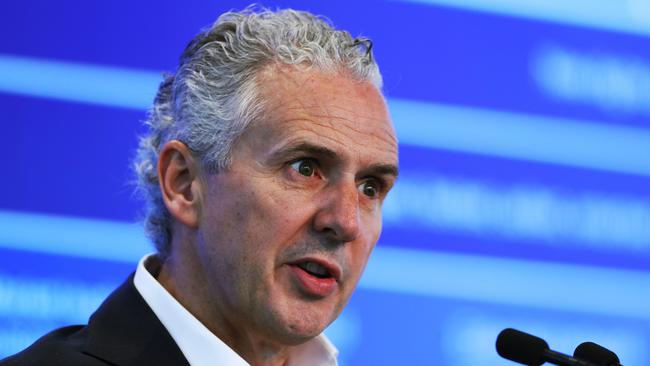NBN still too costly; little economic benefit, says Telstra
NBN pricing levels are still too high and too complex, says Telstra boss Andrew Penn.

Telstra boss Andrew Penn has hosed down the benefits of the latest tweaks to NBN Co’s wholesale prices, saying the company in charge of the National Broadband Network is still charging telcos too much for access.
Speaking at Telstra’s investor day on Wednesday, Mr Penn said NBN Co’s latest measures deliver very little economic benefit for telcos.
“Overall the pricing levels are still too high and the way (NBN Co) is managing the pricing changes is unfortunately creating more complexity.”
“They have introduced a 100/20 plan, we have customers currently on 100/40 plan and will now have to build a new product, as well as, think about how we migrate customers.”
READ MORE: Telstra to pay refunds over excess data charges
“The continued use of discounts and offers also adds more complexity and creates uncertainty,” he said.
Mr Penn had been aggressively pushing NBN Co to dump the controversial connectivity virtual circuit (CVC) charge – the price telcos pay to move data from the NBN to their networks – in the lead up to the new NBN pricing structure.
While NBN Co is sticking with CVC it has decided to offer more off it to telcos across all of the plans and also letting them better manage their data capacity through CVC pooling.
“I want to acknowledge that the team at NBN Co is doing what they can to respond to the market, but our position remains fundamentally the same – the prices are too high, the structure is too complex, CVC adds uncertainty and is going to continue to hold back the retail fixed broadband market.”

Mr Penn’s comments reinforce the ongoing tension between the telcos and NBN Co when it comes to managing the economics of the NBN.
The CVC charges are crucial to NBN Co meeting its financial goals and keep the $51bn network off the federal government’s books. Meanwhile, telcos have labelled CVC an artificial tax on bandwidth that eats into their profits and forces them to maintain high retail NBN prices.
The telco’s investor day in Sydney also saw a couple of announcements on the 5G front and its stand-alone infrastructure business InfraCo.
Telstra’s senior network engineering executive Channa Seneviratne told investors on Wednesday that the telco was extending its 5G coverage at a faster than expected clip.
“We have already extended our coverage beyond the initial 10 cities that we launched with (in May) to a total of 25 cities.”
“Since our launch we have turned on 5G coverage in 15 regional cities, we are building out the coverage in all 25 cities and in due course will announce 10 additional cities.”
“The first sites in a couple of regional cities in South Australia and Western Australia are in the pipeline and coming (online) in December,” he said.
Mr Seneviratne added that the telco’s 5G customers were on average enjoying double the speeds they get on 4G.
“If you stand in a given location and do a speed test on a 5G handset and a speed test on a 4G handset you will see twice the speed … we are receiving very positive feedback from our customers.”
Under the plan restructure, announced by Telstra in June, the telco will offer 5G services to customers for free for 12 months. Customers on premium plans will continue to use 5G without charge after that, while other customers will have to pay $15 a month.
Meanwhile, the head of InfraCo, Brendon Riley, has announced changes to the structure of the business since its creation nine months ago.
“All fibre infrastructure will sit inside InfraCo, originally mobile backhaul was excluded, we felt it’s easier to manage fibre as an end-to-end asset class, with Telstra able to reserve the fibre its requires.”
“Mobile towers will move into InfraCo,” he added.
The move will add an extra $900m to InfraCo’s asset sheet, bulking it up to $11.7bn.
InfraCo is widely seen as a way for Telstra to be make a move on NBN, if and when the network is put up for sale by the federal government.
Mr Penn on Wednesday told investors that InfraCo gives Telstra a seat at the table on any discussion around the fate of the NBN once it’s fully rolled out.
“We are setting up InfraCo with three clear objectives, to provide transparency, improve the way we commercialise (infrastructure assets) and create optionality for the future.”
“People presume that there will naturally be a demerger of our infrastructure assets, that’s not a decision we have taken.”
“It’s something we won’t contemplate until the NBN is rolled out but it makes sense for us to structure is in a way where we achieve the first two objectives and then have options for how the telco market evolves,” he said.



To join the conversation, please log in. Don't have an account? Register
Join the conversation, you are commenting as Logout